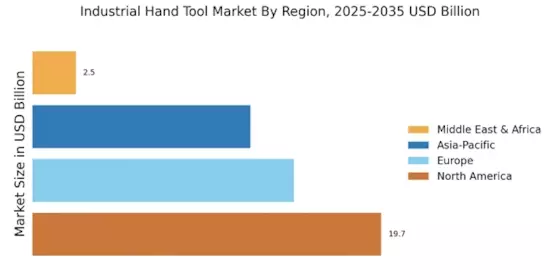Growing DIY Culture
The growing do-it-yourself (DIY) culture is significantly influencing the Industrial Hand Tool Market. As more individuals engage in home improvement and renovation projects, the demand for hand tools is on the rise. This trend is particularly evident among millennials and younger generations, who are increasingly inclined to undertake DIY tasks. Market data suggests that the DIY home improvement market is projected to grow at a compound annual growth rate of around 4.2%. Consequently, retailers are expanding their offerings of hand tools to cater to this burgeoning consumer base. The increased accessibility of information through online platforms further empowers consumers to take on projects, thereby driving the demand for a wide range of hand tools within the Industrial Hand Tool Market.
Focus on Safety Standards
The emphasis on safety standards within the Industrial Hand Tool Market is becoming increasingly pronounced. Regulatory bodies are implementing stringent safety regulations to ensure the well-being of workers in various industries. This focus on safety is prompting manufacturers to innovate and produce hand tools that meet or exceed these standards. Tools designed with safety features, such as ergonomic grips and protective mechanisms, are gaining traction among consumers. Moreover, companies that prioritize safety in their product offerings are likely to enhance their market position. As industries continue to prioritize worker safety, the demand for compliant and safe hand tools is expected to grow, thereby positively impacting the Industrial Hand Tool Market.
Technological Advancements
Technological advancements play a pivotal role in shaping the Industrial Hand Tool Market. The integration of innovative materials and manufacturing processes has led to the development of more durable and efficient tools. For instance, the introduction of high-strength alloys and advanced coatings enhances the performance and longevity of hand tools. Additionally, the rise of smart technology, such as tools equipped with sensors and connectivity features, is transforming traditional hand tools into multifunctional devices. This evolution not only improves user experience but also increases productivity on job sites. As a result, the market is witnessing a shift towards high-tech hand tools, which are expected to capture a significant share of the Industrial Hand Tool Market in the coming years.
Rising Construction Activities
The Industrial Hand Tool Market is experiencing a surge in demand due to increasing construction activities across various sectors. As urbanization accelerates, the need for residential, commercial, and infrastructure projects intensifies. This trend is reflected in the construction industry's projected growth rate, which is expected to reach approximately 5.5% annually over the next few years. Consequently, the demand for industrial hand tools, which are essential for construction tasks, is likely to rise significantly. The expansion of construction projects necessitates a diverse range of hand tools, from basic hammers to specialized equipment, thereby driving the market forward. Furthermore, government initiatives aimed at improving infrastructure are likely to bolster this demand, creating a favorable environment for the Industrial Hand Tool Market.
Expansion of E-commerce Platforms
The expansion of e-commerce platforms is reshaping the Industrial Hand Tool Market by providing consumers with greater access to a wide range of products. Online retailing has become a preferred shopping method for many, offering convenience and competitive pricing. This shift is particularly beneficial for niche tool manufacturers who can reach a broader audience without the need for extensive physical retail presence. Market analysis indicates that e-commerce sales in the hand tool sector are projected to grow significantly, driven by the increasing preference for online shopping. As consumers seek convenience and variety, the Industrial Hand Tool Market is likely to see a substantial increase in sales through digital channels, further propelling market growth.


















Leave a Comment